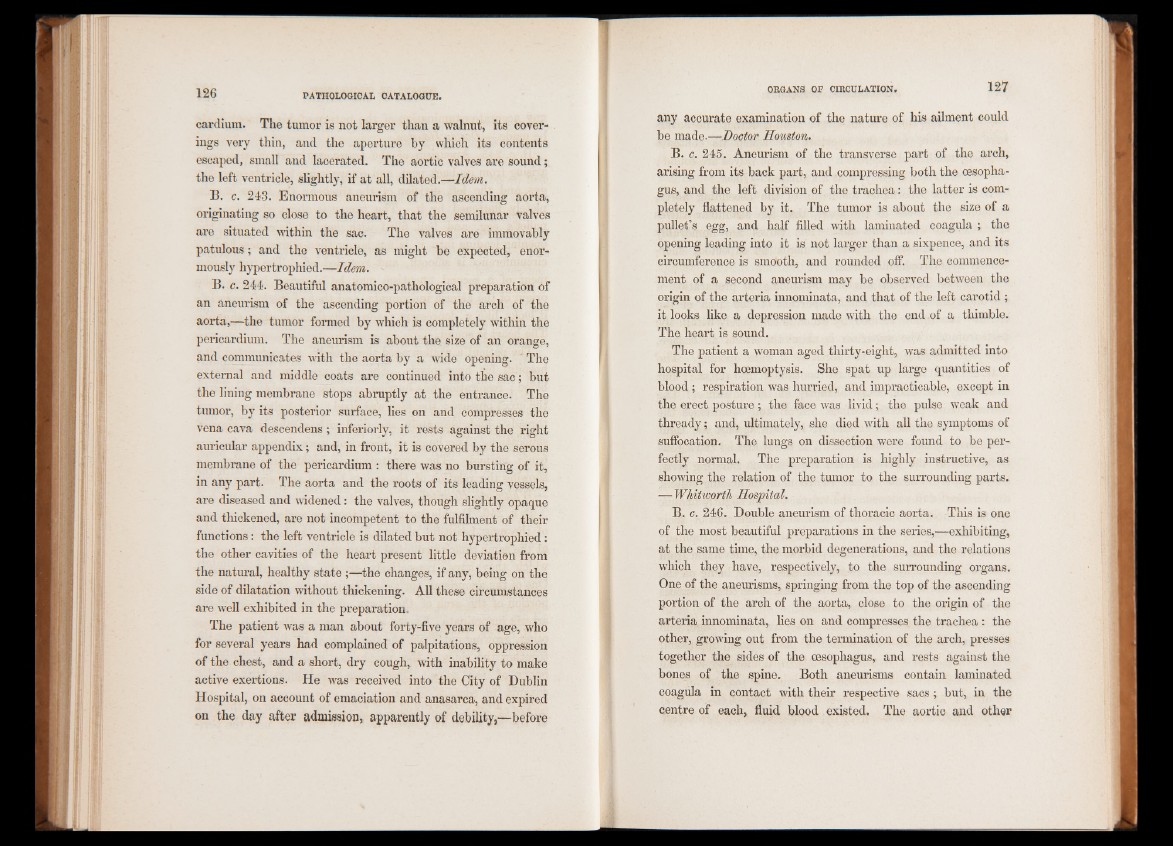
cardium. The tumor is not larger than a walnut, its coverings
very thin, and the aperture by which its contents
escaped, small and lacerated. The aortic valves are sound;
the left ventricle, slightly, if at all, dilated.—Idem.
B. c. 243. Enormous aneurism of the ascending aorta,
originating so close to the heart, that the semilunar valves
are situated within the sac. The valves are immovably
patulous; and the ventricle, as might be expected, enormously
hypertrophied.—Idem.
B. c. 244. Beautiful anatomico-pathological preparation of
an aneurism of the ascending portion of the arch of the
aorta,—the tumor formed by which is completely within the
pericardium. The aneurism is about the size of an orange,
and communicates with the aorta by a wide opening. ' The
external and middle coats are continued into the sac; but
the lining membrane stops abruptly at the entrance. The
tumor, by its posterior surface, lies on and compresses the
vena cava descendens; inferiorly, it rests against the right
auricular appendix; and, in front, it is covered by the serous
membrane of the pericardium : there was no bursting of it,
in any part. The aorta and the roots of its leading vessels,
are diseased and widened: the valves, though slightly opaque
and thickened, are not incompetent to the fulfilment of their
functions: the left ventricle is dilated but not hypertrophied:
the other cavities of the heart present little deviation from
the natural, healthy state ;—the changes, if any, being on the
side of dilatation without thickening. All these circumstances
are well exhibited in the preparation.
The patient was a man about forty-five years of age, who
for several years had complained of palpitations, oppression
of the chest, and a short, dry cough, with inability to make
active exertions. He was received into the City of Dublin
Hospital, on account of emaciation and anasarca, and expired
on the day after admission, apparently of debility,—before
any accurate examination of the nature of his ailment could
be made.—Doctor Houston.
B. c. 245. Aneurism of the transverse part of the arch,
arising from its back part, and compressing both the oesophagus,
and the left division of the trachea: the latter is completely
flattened by it. The tumor is about the size of a
pullet’s egg, and half filled with laminated coagula ; the
opening leading into it is not larger than a sixpence, and its
circumference is smooth, and rounded off. The commencement
of a second aneurism may be observed between the
origin of the arteria innominata, and that of the left carotid ;
it looks like a depression made with the end of a thimble.
The heart is sound.
The patient a woman aged thirty-eight, was admitted into
hospital for hoemoptysis. She spat up large quantities of
blood ; respiration was hurried, and impracticable, except in
the erect posture; the face was livid; the pulse weak and
thready; and, ultimately, she died with all the symptoms of
suffocation. The lungs on dissection, were found to be perfectly
normal. The preparation is highly instructive, as
showing the relation of the tumor to the surrounding parts.
— Whitworth Hospital.
B. c. 246. Double aneurism of thoracic aorta. This is one
of the most beautiful preparations in the series,—exhibiting,
at the same time, the morbid degenerations, and the relations
which they have, respectively, to the surrounding organs.
One of the aneurisms, springing from the top of the ascending
portion of the arch of the aorta, close to the origin of the
arteria innominata, lies on and compresses the trachea : the
other, growing out from the termination of the arch, presses
together the sides of the oesophagus, and rests against the
bones of the spine. Both aneurisms contain laminated
coagula in contact with their respective sacs; but, in the
centre of each, fluid blood existed. The aortic and other